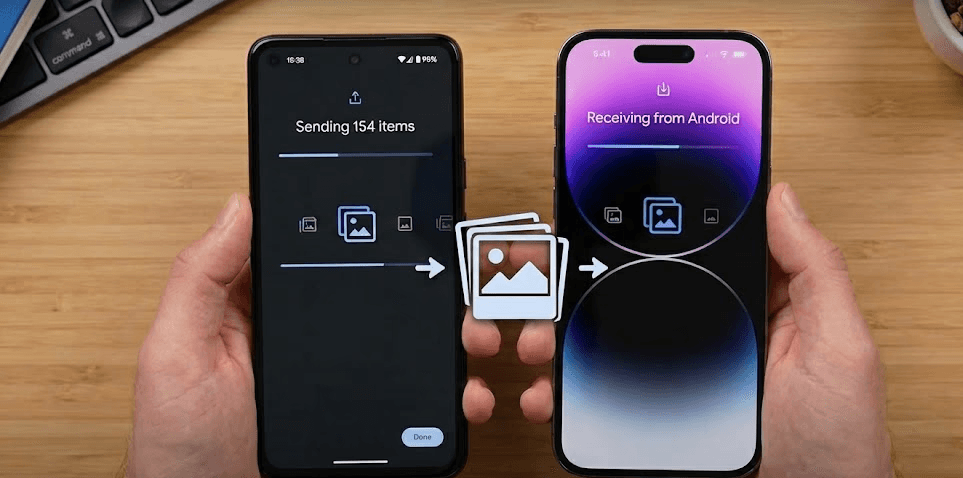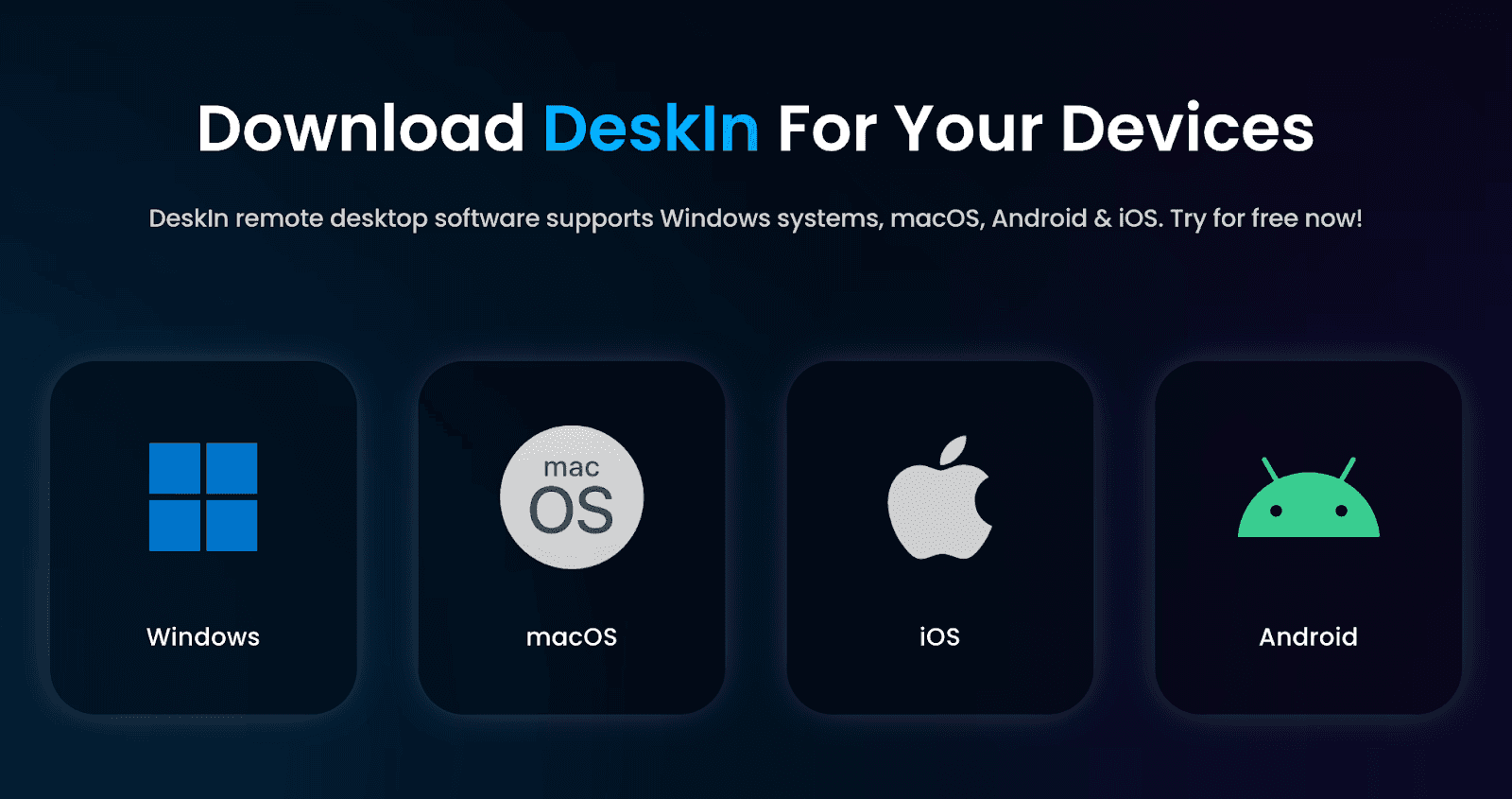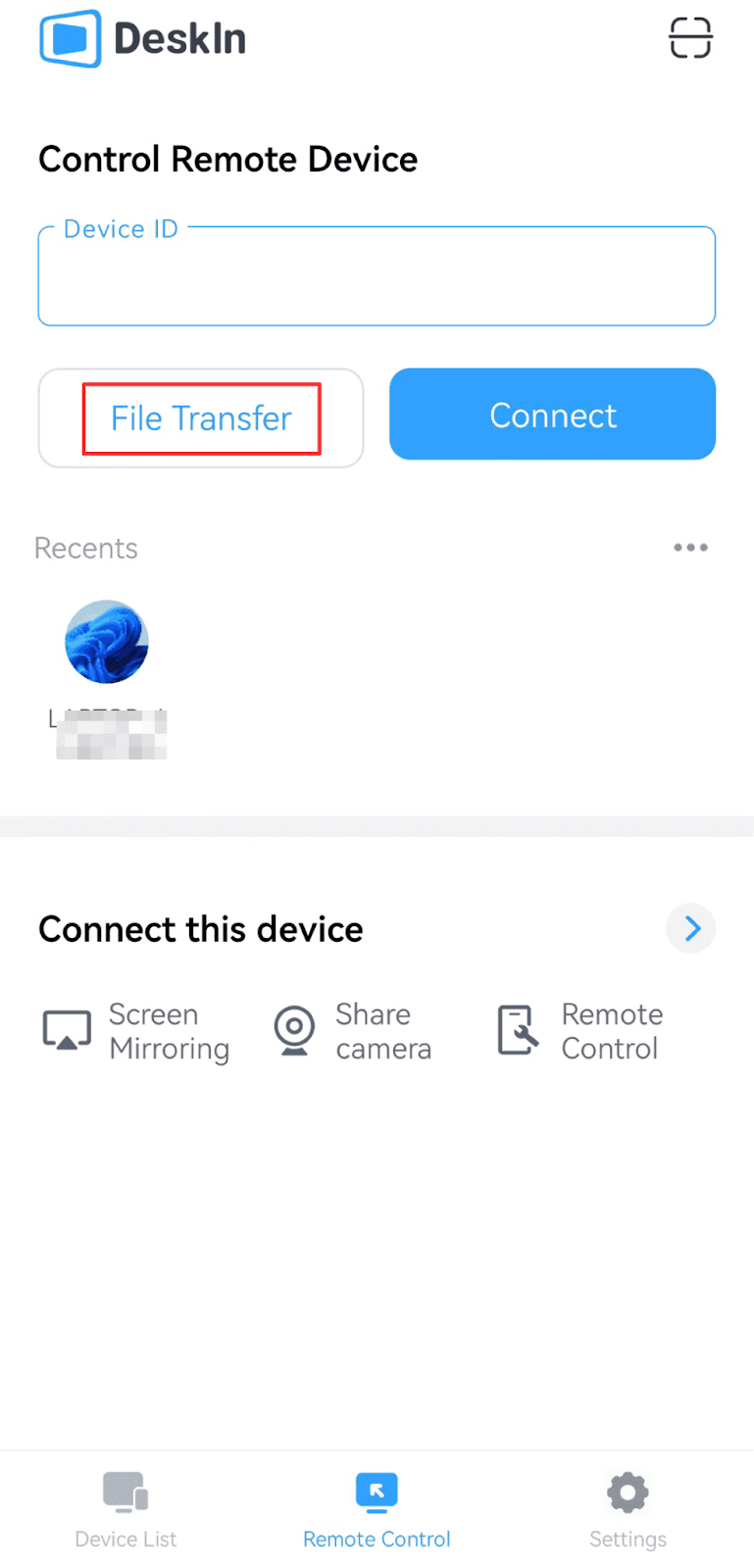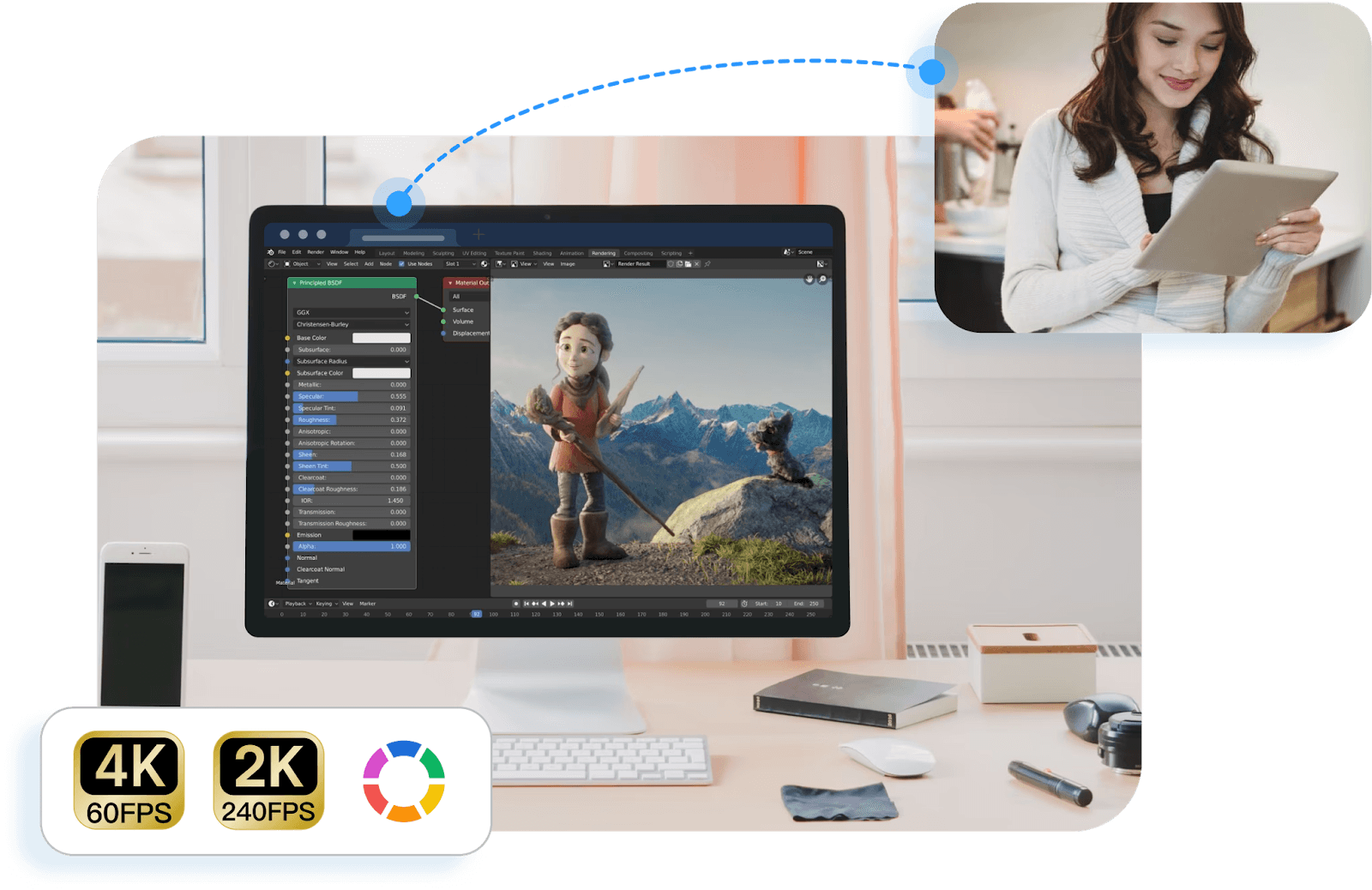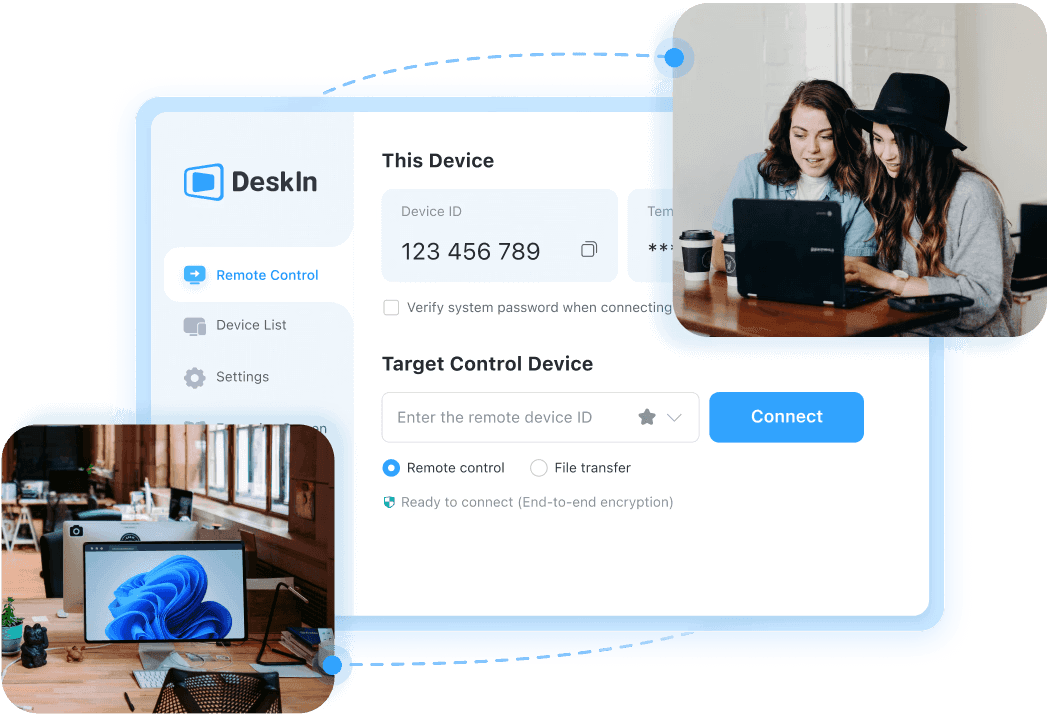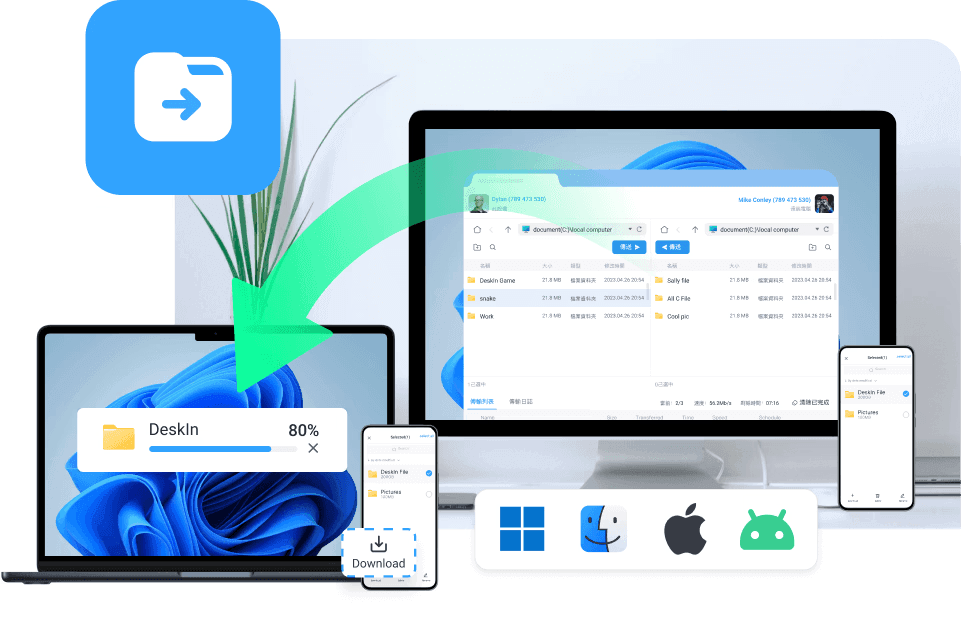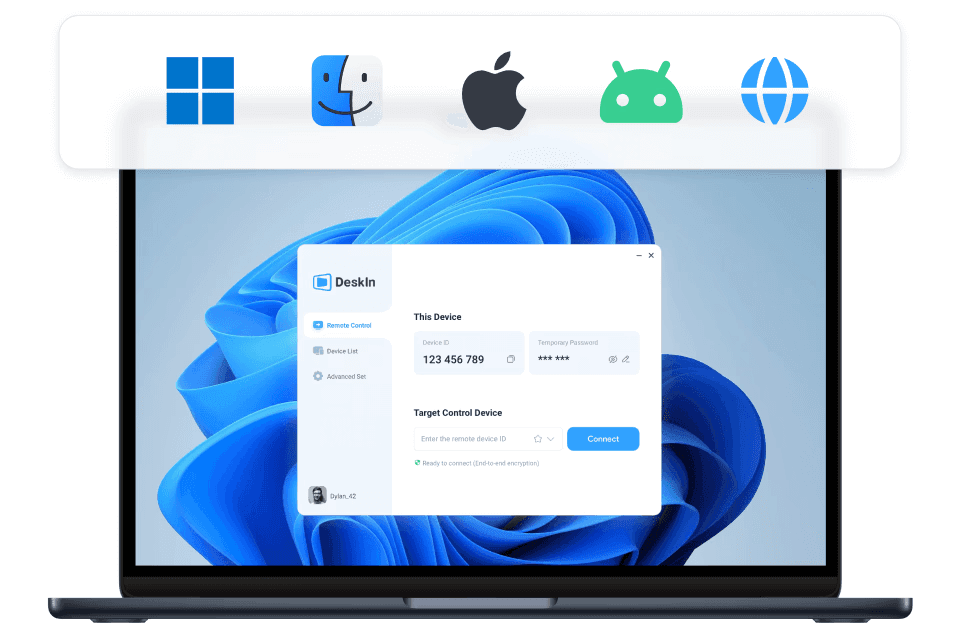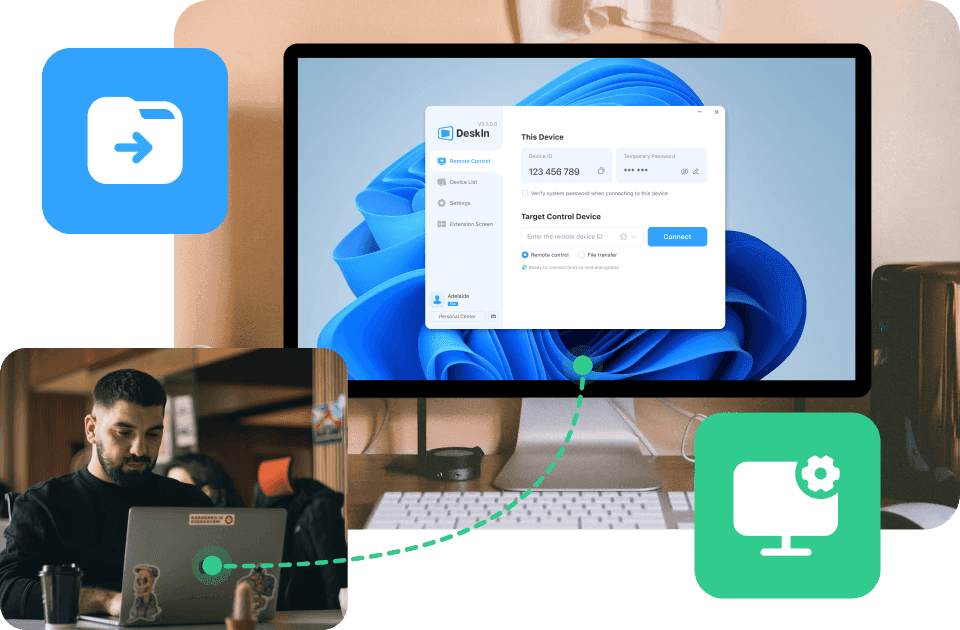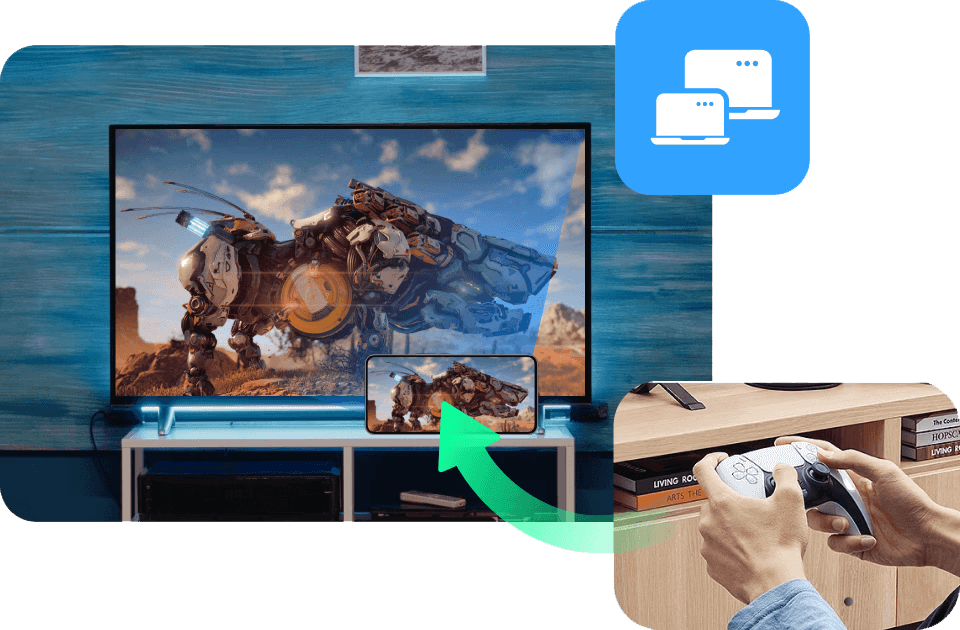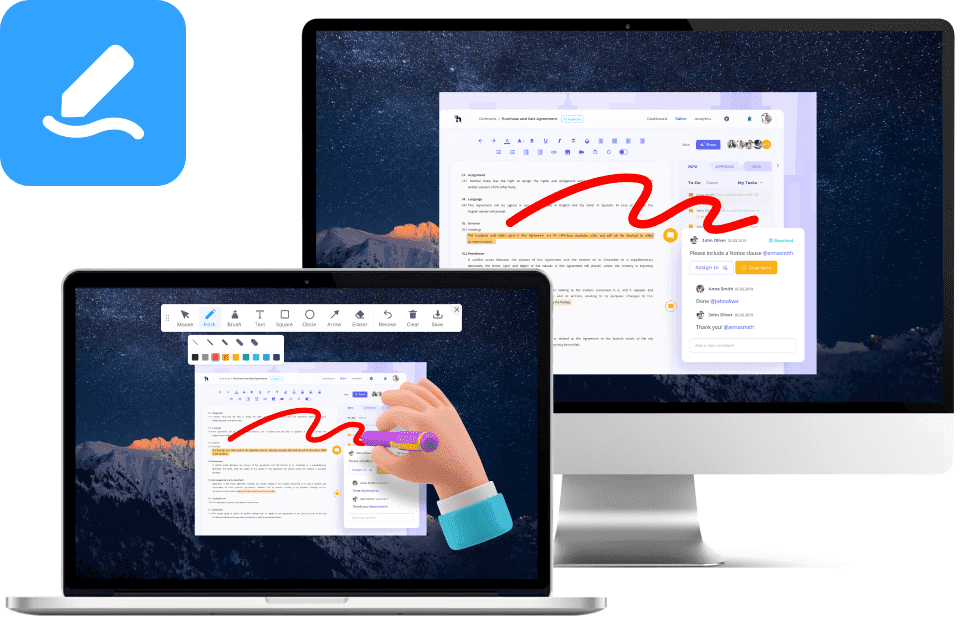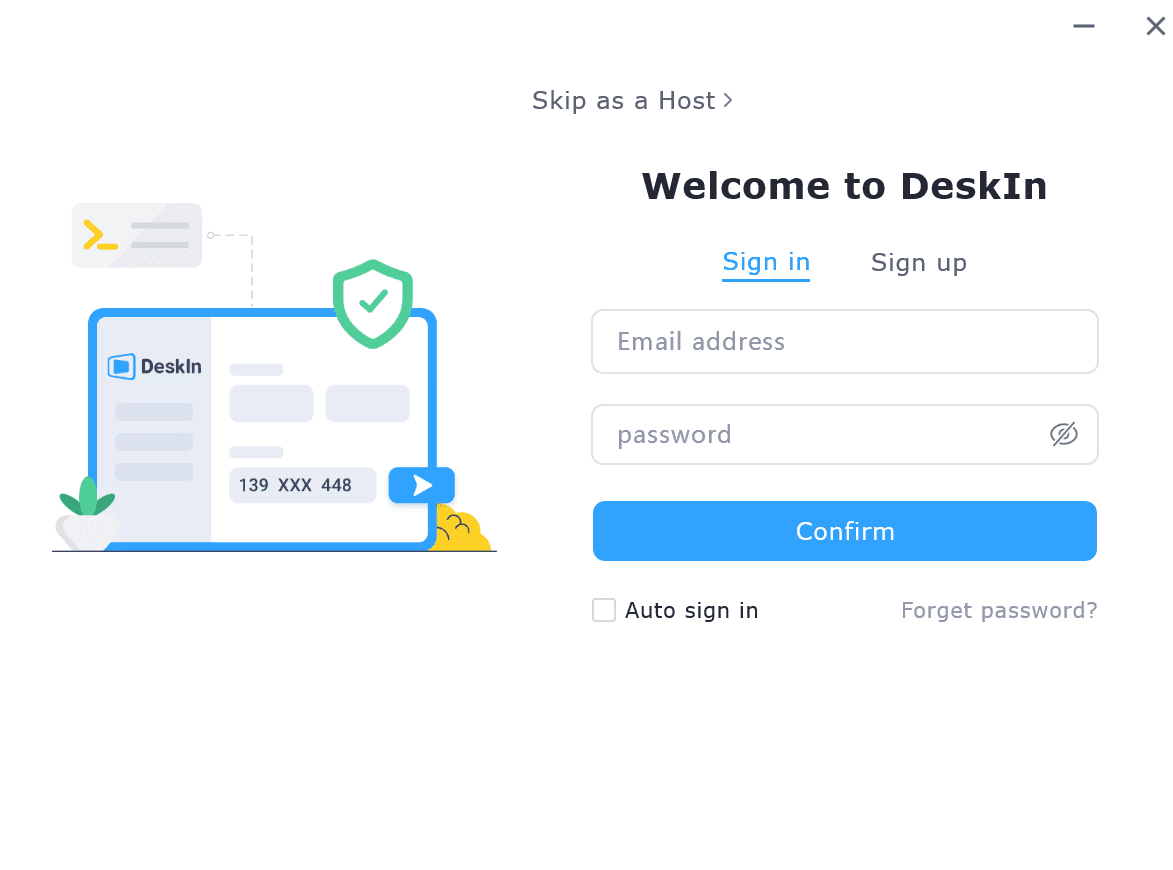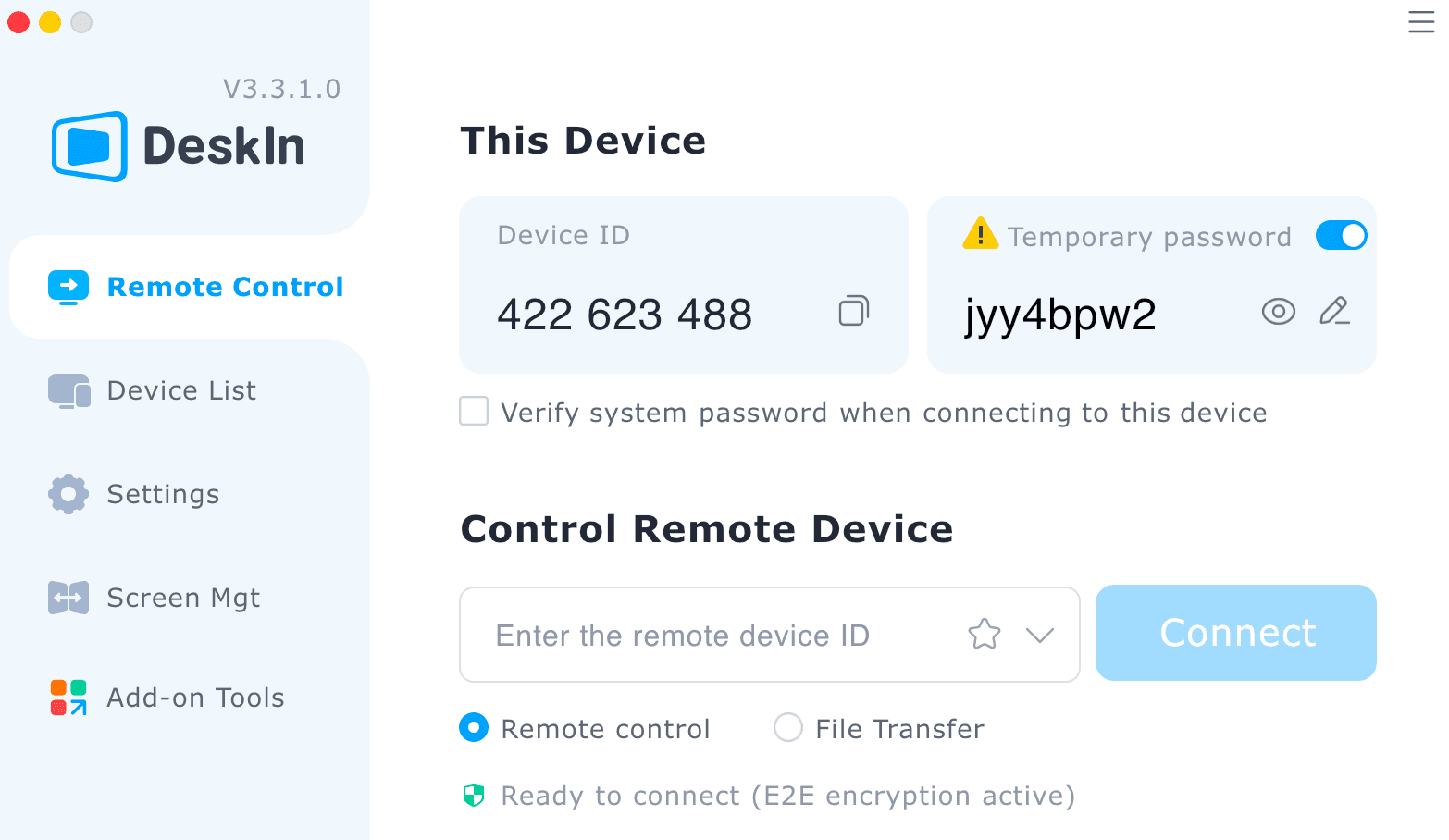リモートワークやコンテンツ制作の台頭に伴い、2台のコンピュータで1つのスクリーンを共有する必要性が増しています。デュアルモニターワークステーションを設定したり、ラップトップをデスクトップに接続したり、柔軟なスクリーン共有設定を望む際、実現する簡単な方法があります。
レンダリングやシミュレーションを1台のPCで行う際、ゲームやチャット用に他のPCに簡単に切り替えることができ、ケーブルの頻繁な差し込み抜きを避けられます。
このガイドでは、DeskIn リモートデスクトップソフトウェア、KVMスイッチ、Microsoft Quick Assist、Windows Miracastワイヤレス投影の4つの実用的なソリューションを紹介します。Windows-to-Windowsの接続やMac-to-Windowsのリモートアクセスの設定、安定した拡張モニターの設定を目的とする場合でも、ここで最適な方法を見つけることができます。
なぜ他のコンピューターとスクリーンを共有するのでしょうか?
ハイブリッドワークとクリエイティブワークフローの時代において、多くのプロフェッショナルにとって2台のコンピュータで1つのスクリーンを共有することは実用的なニーズです。たとえば、ビデオのレンダリングや3Dモデリング、コーディング中に1台のコンピュータが処理を担当し、他方が会議、リサーチ、またはエンターテインメントに使われます。このセットアップはデスクスペースを節約し、マルチタスクの効率を向上させます。
主なメリット
ラップトップスクリーンの拡張: 外部モニターが同期して表示・操作します。
柔軟なデュアルスクリーン設定: 表示タスクを簡単に切り替えたり分割したりできます。
2つのウィンドウを同時に表示できます: 比較やマルチタスクに最適です。
各スクリーンに異なる壁紙: 独立した環境を維持できます。
クイックで便利: ケーブルや互換性の心配がありません。
「1台のコンピュータに2台のモニター」ではないこのセットアップにより、2つの異なるシステムが1つのディスプレイをシェアし、ソフトウェアやハードウェアでよりスムーズに切り替えることで、柔軟なワークフローが実現します。
方法1: DeskIn リモートデスクトップソフトウェア – 他のコンピューターとのスクリーン共有の最も簡単な方法

追加のハードウェアを購入することなく、異なるコンピュータ間でスクリーンを切り替えたり共有したりしたい場合、DeskInは最も直感的で多用途の選択肢です。リモートアクセスとクロスデバイスのスクリーン共有を目的に設計されており、同じネットワークにいなくてもラップトップとデスクトップを簡単に接続できます。
理想的な活用方法
リモートワーク、チームコラボレーション、クロスデバイスコントロール(ラップトップ+デスクトップ)
ハードウェアコストを節約したいユーザー(KVMスイッチ不要)
異なる場所またはネットワークから他のデバイスにアクセスする必要がある人々
主要な利点
高画質で低遅延のパフォーマンス: 最大4K解像度をサポートし、遅延<40msでクリアで精密なビジュアル。
リアルタイムの応答性: スムーズなカーソル移動とクリック反応—デザインレビュー、教育、コード検査に最適。
内蔵のコラボレーションツール: ボイスチャットとホワイトボード注釈を含み、ライブ教育やチームの議論が可能。
クロスプラットフォーム互換性: Windows、Mac、モバイルデバイスでシームレスに動作し、マルチデバイスの同期をサポート。
マルチディスプレイミラーリング: 1台のコンピュータを複数のスクリーンにミラーリング—プレゼンテーションやリモート会議に最適。
無料で初心者にも優しい: モダンで直感的なインターフェースで簡単に設定が可能。
💡 注意: 最初にDeskInを両方のデバイスにインストールする必要がありますが、セットアップは数分で完了します。
類似のツールを探しているなら、こちらをチェック:
DeskInセットアップチュートリアル | 他のコンピューターとスクリーンを共有する方法
以下の簡単なステップに従って、DeskInを利用してスクリーンを共有またはラップトップディスプレイを拡張しましょう:
1. ダウンロードとサインイン
DeskInのウェブサイトにアクセスし、アプリを両方のコンピュータにインストールします。同じアカウントでログインし、リモート接続とスクリーン共有を有効にします。


2. ミラーリングまたは拡張モードを選択
サイドバーから「スクリーンミラーリング/拡張」をクリックします。その後、「Start Mirroring」または「Start Extending」を選択し、2台のコンピューター間でスクリーンを共有します。

3. 共有の開始または接続の終了
接続が完了したら、ファイルを転送し、声でチャットし、瞬時にスクリーンを共有できます。終了する際は、「リモートコントロールを終了」をクリックしてプライバシーを確保します。

その他のおすすめの読み物:
方法2: KVMスイッチを使用する — 2台のPC間で1つのモニターを共有するハードウェアソリューション

もし2台のPCで1つのモニターと同じキーボードとマウスを使用したい場合は、KVM (Keyboard Video Mouse) スイッチを検討してください。このハードウェアデバイスは、HDMIやUSBを介して2台のコンピューターを接続し、ケーブルを抜いたりアカウントにサインインしたりすることなく、ディスプレイを瞬時に切り替えることができます。
理想的な活用方法
1つのモニター、キーボード、マウスで2台のPCを制御したいユーザー
仕事用とゲーム用のPCを頻繁に切り替える人
安定したゼロ遅延のハードウェアを好むユーザー
利点
シンプルなプラグアンドプレイのセットアップ
ほぼゼロの遅延で、ゲームやメディア使用に理想的
ソフトウェアインストール不要
欠点
別途ハードウェア購入が必要
一部のモデルは4K / 144Hzモニターをサポートしない場合があります
ラップトップがHDMI入力をサポートしている場合、デュアルディスプレイモード間で直接切り替えることができます。ただし、大多数のラップトップは出力のみのサポートであり、入力はサポートしていません。この制限を迂回するには、DeskInを使用してソフトウェアベースのマルチPCコントロールを実現し、ケーブルを使わずに行います。
または、以下もチェックしてください:
KVMセットアップガイド | 2台のコンピュータ間で1つのスクリーンを迅速に切り替える
KVMスイッチを設定するには:
デバイスを接続する
モニター、キーボード、マウスをKVMスイッチにプラグインします。
各PCをHDMI/USBケーブルでKVMに接続します。

コンピュータ間の切り替え
パネルボタン: スイッチの物理ボタンを押してコンピューター間を切り替えます。
キーボードショートカット: Scroll Lock + 数字キーをダブルタップして入力を切り替えます。
OSDメニュー: 一部のモデルではオンスクリーンメニューで切り替えが提供されています。
マウスジェスチャースイッチング: 高度なモデルではマウスを使った切り替えが可能です。
このセットアップにより、システム間でケーブルなしで迅速に切り替えが可能になり、効率的なマルチPCワークフローが実現します。
方法3: Microsoft Quick Assistを使用して2つのWindowsコンピューター間でスクリーンを共有する

Microsoft Quick Assistは、サードパーティソフトウェアを必要とせずに2台のコンピューターが安全にスクリーンを共有できる、Windowsに標準搭載されたリモートコントロールツールです。両者はQuick Assistを開いて、一時的なセキュリティコードを使って接続します。
特にWindows-to-Windowsのセットアップに便利で、リモート教育、ITサポート、クイックコラボレーションに最適です。
利点
完全無料: Windowsにプリインストールされています。
安全な接続: 一時的な検証コードを使用します。
シンプルなインターフェイス: 直感的で初心者にも優しいです。
マウス/キーボードコントロールをサポート: 指導やトラブルシューティングに最適です。
欠点
Windows専用: MacやLinuxのサポートはありません。
インターネット速度に依存: 遅いネットワークでは遅延が発生する可能性があります。
Macをお使いの場合、互換性の問題なしでマルチプラットフォームのスクリーン共有が可能なDeskInを試してみてください。また、以下もチェックしてください: MacでMicrosoftリモートデスクトップを使用する方法 [完全ガイド]
Quick Assistセットアップガイド | Windowsでラップトップスクリーンを共有または拡張する
Quick Assistを使用して2台のWindowsラップトップ間でスクリーンを共有するには:
アプリを起動する
Win + S を押し、「Quick Assist」を検索して開きます。アシスタンスモードを選択する
メイン(制御)PCで「他の人を支援する」をクリックします。サインイン
Microsoftアカウントでログインしてセキュリティコードを生成します。セキュリティコードを入力する
他のラップトップで、「アシスタンスを受ける」の下にコードを入力して送信します。
注意: セキュリティコードは10分で期限切れになります。スクリーン共有を許可する
受信PCで「許可」をクリックします。リモートコントロールを開始する
「画面を見る」か「完全コントロールを取る」を選択します。
コントロール中は、ツールバーを使用して再起動、タスクマネージャーの起動、メッセージの送信を行うことができます。終了する際は、セッションを終了するだけです。次回の接続には新しいコードが必要です。
方法4: Windows Miracast ワイヤレスディスプレイを使用する

2台のラップトップ間でHDMIケーブルを使わずに無線でスクリーンを拡張またはミラーリングしたい場合、Windows Miracastは便利なビルトインソリューションです。同じWi-Fiネットワークを介して、ワイヤレス投影とディスプレイシェアリングが可能です。
理想的な使用ケース
ワイヤレスデュアルモニター設定を作成
会議やデモに一方のラップトップをもう一方に投影
プレゼンテーション中に迅速にビジュアルを共有します
利点
ソフトウェアインストール不要
「複製」または「拡張」表示モードをサポート
迅速で安定した接続
まず互換性を確認してください:Win + Pを押す。もし「ワイヤレスディスプレイに接続」が表示されれば、デバイスはMiracastをサポートします。
欠点
両デバイスがMiracastをサポートしている必要があります
品質や遅延がWi-Fiの安定性に依存します
もしデバイスが異なるプラットフォームにある(例えば、Mac+Windows)、DeskInを使用してスムーズなクロスシステムのシェアリングを行ってください。
Miracastセットアップガイド | ラップトップディスプレイの拡張またはスクリーンをワイヤレスで共有する
接続パネルを開く
通知センターアイコンをクリックするか、Win + Kを押して「接続」を開きます。
利用可能なデバイスを見つける
近くのMiracast対応PCのリストからターゲットデバイスを選択します。
入力制御を許可
「接続デバイスからの入力を許可」をチェックしてキーボードとマウスのコントロールを可能にします。
接続が完了すると、2台のラップトップはミラーまたは拡張スクリーンをワイヤレスで表示できるようになり、モバイルで煩雑ではないデュアルスクリーン設定に最適です。
FAQ | トラブルシューティングとよくある質問
2台のWindows 11 ラップトップでワイヤレスデュアルスクリーンを設定するには?
MiracastまたはDeskInを使用してワイヤレスで接続します。ケーブルなしでディスプレイを拡張でき、マルチタスクやリモートコラボレーションに最適です。
2台のコンピューターを同期させるには?
ディスプレイ設定で拡張または複製モードを選択します。スムーズなデュアルディスプレイパフォーマンスのためにモニターの配置と解像度を調整します。
なぜマウスが画面を横断できないのですか?
設定 → システム → ディスプレイの下でディスプレイの配置を確認します。画面の順序を物理配置に合わせて調整します。
ディスプレイを切り替えるショートカットは何ですか?
Windows + Pを押して投影メニューを開きます。「複製」、「拡張」、または「セカンドスクリーンのみ」から選択してください。
まとめ:2台のコンピューター間で1つのスクリーンを共有するのに最適な方法は?
以下は4つの方法の簡単なまとめです:
DeskIn: 最も柔軟で完全なオプション—ネットワークを越えたマルチデバイスで、スクリーン拡張とコラボレーションツールを含む。
KVMスイッチ: ゲーマーやハードウェアベースのゼロ遅延コントロールを好むプロフェッショナルに最適。
Microsoft Quick Assist: Windows専用セットアップに最適な無料ツール。
Miracast: 無線で、ケーブル不要の環境に最適。
総合的に見ると、DeskInは最も包括的でユーザーフレンドリーなソリューションとして優れており、優れたパフォーマンス、クロスプラットフォームサポート、リモートアクセスの利便性をすべて1つのツールで提供しています。
👉 今すぐDeskInをダウンロードして、2台のコンピューター間でのスクリーン共有を簡単に始めましょう。

リモートワークやコンテンツ制作の台頭に伴い、2台のコンピュータで1つのスクリーンを共有する必要性が増しています。デュアルモニターワークステーションを設定したり、ラップトップをデスクトップに接続したり、柔軟なスクリーン共有設定を望む際、実現する簡単な方法があります。
レンダリングやシミュレーションを1台のPCで行う際、ゲームやチャット用に他のPCに簡単に切り替えることができ、ケーブルの頻繁な差し込み抜きを避けられます。
このガイドでは、DeskIn リモートデスクトップソフトウェア、KVMスイッチ、Microsoft Quick Assist、Windows Miracastワイヤレス投影の4つの実用的なソリューションを紹介します。Windows-to-Windowsの接続やMac-to-Windowsのリモートアクセスの設定、安定した拡張モニターの設定を目的とする場合でも、ここで最適な方法を見つけることができます。
なぜ他のコンピューターとスクリーンを共有するのでしょうか?
ハイブリッドワークとクリエイティブワークフローの時代において、多くのプロフェッショナルにとって2台のコンピュータで1つのスクリーンを共有することは実用的なニーズです。たとえば、ビデオのレンダリングや3Dモデリング、コーディング中に1台のコンピュータが処理を担当し、他方が会議、リサーチ、またはエンターテインメントに使われます。このセットアップはデスクスペースを節約し、マルチタスクの効率を向上させます。
主なメリット
ラップトップスクリーンの拡張: 外部モニターが同期して表示・操作します。
柔軟なデュアルスクリーン設定: 表示タスクを簡単に切り替えたり分割したりできます。
2つのウィンドウを同時に表示できます: 比較やマルチタスクに最適です。
各スクリーンに異なる壁紙: 独立した環境を維持できます。
クイックで便利: ケーブルや互換性の心配がありません。
「1台のコンピュータに2台のモニター」ではないこのセットアップにより、2つの異なるシステムが1つのディスプレイをシェアし、ソフトウェアやハードウェアでよりスムーズに切り替えることで、柔軟なワークフローが実現します。
方法1: DeskIn リモートデスクトップソフトウェア – 他のコンピューターとのスクリーン共有の最も簡単な方法

追加のハードウェアを購入することなく、異なるコンピュータ間でスクリーンを切り替えたり共有したりしたい場合、DeskInは最も直感的で多用途の選択肢です。リモートアクセスとクロスデバイスのスクリーン共有を目的に設計されており、同じネットワークにいなくてもラップトップとデスクトップを簡単に接続できます。
理想的な活用方法
リモートワーク、チームコラボレーション、クロスデバイスコントロール(ラップトップ+デスクトップ)
ハードウェアコストを節約したいユーザー(KVMスイッチ不要)
異なる場所またはネットワークから他のデバイスにアクセスする必要がある人々
主要な利点
高画質で低遅延のパフォーマンス: 最大4K解像度をサポートし、遅延<40msでクリアで精密なビジュアル。
リアルタイムの応答性: スムーズなカーソル移動とクリック反応—デザインレビュー、教育、コード検査に最適。
内蔵のコラボレーションツール: ボイスチャットとホワイトボード注釈を含み、ライブ教育やチームの議論が可能。
クロスプラットフォーム互換性: Windows、Mac、モバイルデバイスでシームレスに動作し、マルチデバイスの同期をサポート。
マルチディスプレイミラーリング: 1台のコンピュータを複数のスクリーンにミラーリング—プレゼンテーションやリモート会議に最適。
無料で初心者にも優しい: モダンで直感的なインターフェースで簡単に設定が可能。
💡 注意: 最初にDeskInを両方のデバイスにインストールする必要がありますが、セットアップは数分で完了します。
類似のツールを探しているなら、こちらをチェック:
DeskInセットアップチュートリアル | 他のコンピューターとスクリーンを共有する方法
以下の簡単なステップに従って、DeskInを利用してスクリーンを共有またはラップトップディスプレイを拡張しましょう:
1. ダウンロードとサインイン
DeskInのウェブサイトにアクセスし、アプリを両方のコンピュータにインストールします。同じアカウントでログインし、リモート接続とスクリーン共有を有効にします。


2. ミラーリングまたは拡張モードを選択
サイドバーから「スクリーンミラーリング/拡張」をクリックします。その後、「Start Mirroring」または「Start Extending」を選択し、2台のコンピューター間でスクリーンを共有します。

3. 共有の開始または接続の終了
接続が完了したら、ファイルを転送し、声でチャットし、瞬時にスクリーンを共有できます。終了する際は、「リモートコントロールを終了」をクリックしてプライバシーを確保します。

その他のおすすめの読み物:
方法2: KVMスイッチを使用する — 2台のPC間で1つのモニターを共有するハードウェアソリューション

もし2台のPCで1つのモニターと同じキーボードとマウスを使用したい場合は、KVM (Keyboard Video Mouse) スイッチを検討してください。このハードウェアデバイスは、HDMIやUSBを介して2台のコンピューターを接続し、ケーブルを抜いたりアカウントにサインインしたりすることなく、ディスプレイを瞬時に切り替えることができます。
理想的な活用方法
1つのモニター、キーボード、マウスで2台のPCを制御したいユーザー
仕事用とゲーム用のPCを頻繁に切り替える人
安定したゼロ遅延のハードウェアを好むユーザー
利点
シンプルなプラグアンドプレイのセットアップ
ほぼゼロの遅延で、ゲームやメディア使用に理想的
ソフトウェアインストール不要
欠点
別途ハードウェア購入が必要
一部のモデルは4K / 144Hzモニターをサポートしない場合があります
ラップトップがHDMI入力をサポートしている場合、デュアルディスプレイモード間で直接切り替えることができます。ただし、大多数のラップトップは出力のみのサポートであり、入力はサポートしていません。この制限を迂回するには、DeskInを使用してソフトウェアベースのマルチPCコントロールを実現し、ケーブルを使わずに行います。
または、以下もチェックしてください:
KVMセットアップガイド | 2台のコンピュータ間で1つのスクリーンを迅速に切り替える
KVMスイッチを設定するには:
デバイスを接続する
モニター、キーボード、マウスをKVMスイッチにプラグインします。
各PCをHDMI/USBケーブルでKVMに接続します。

コンピュータ間の切り替え
パネルボタン: スイッチの物理ボタンを押してコンピューター間を切り替えます。
キーボードショートカット: Scroll Lock + 数字キーをダブルタップして入力を切り替えます。
OSDメニュー: 一部のモデルではオンスクリーンメニューで切り替えが提供されています。
マウスジェスチャースイッチング: 高度なモデルではマウスを使った切り替えが可能です。
このセットアップにより、システム間でケーブルなしで迅速に切り替えが可能になり、効率的なマルチPCワークフローが実現します。
方法3: Microsoft Quick Assistを使用して2つのWindowsコンピューター間でスクリーンを共有する

Microsoft Quick Assistは、サードパーティソフトウェアを必要とせずに2台のコンピューターが安全にスクリーンを共有できる、Windowsに標準搭載されたリモートコントロールツールです。両者はQuick Assistを開いて、一時的なセキュリティコードを使って接続します。
特にWindows-to-Windowsのセットアップに便利で、リモート教育、ITサポート、クイックコラボレーションに最適です。
利点
完全無料: Windowsにプリインストールされています。
安全な接続: 一時的な検証コードを使用します。
シンプルなインターフェイス: 直感的で初心者にも優しいです。
マウス/キーボードコントロールをサポート: 指導やトラブルシューティングに最適です。
欠点
Windows専用: MacやLinuxのサポートはありません。
インターネット速度に依存: 遅いネットワークでは遅延が発生する可能性があります。
Macをお使いの場合、互換性の問題なしでマルチプラットフォームのスクリーン共有が可能なDeskInを試してみてください。また、以下もチェックしてください: MacでMicrosoftリモートデスクトップを使用する方法 [完全ガイド]
Quick Assistセットアップガイド | Windowsでラップトップスクリーンを共有または拡張する
Quick Assistを使用して2台のWindowsラップトップ間でスクリーンを共有するには:
アプリを起動する
Win + S を押し、「Quick Assist」を検索して開きます。アシスタンスモードを選択する
メイン(制御)PCで「他の人を支援する」をクリックします。サインイン
Microsoftアカウントでログインしてセキュリティコードを生成します。セキュリティコードを入力する
他のラップトップで、「アシスタンスを受ける」の下にコードを入力して送信します。
注意: セキュリティコードは10分で期限切れになります。スクリーン共有を許可する
受信PCで「許可」をクリックします。リモートコントロールを開始する
「画面を見る」か「完全コントロールを取る」を選択します。
コントロール中は、ツールバーを使用して再起動、タスクマネージャーの起動、メッセージの送信を行うことができます。終了する際は、セッションを終了するだけです。次回の接続には新しいコードが必要です。
方法4: Windows Miracast ワイヤレスディスプレイを使用する

2台のラップトップ間でHDMIケーブルを使わずに無線でスクリーンを拡張またはミラーリングしたい場合、Windows Miracastは便利なビルトインソリューションです。同じWi-Fiネットワークを介して、ワイヤレス投影とディスプレイシェアリングが可能です。
理想的な使用ケース
ワイヤレスデュアルモニター設定を作成
会議やデモに一方のラップトップをもう一方に投影
プレゼンテーション中に迅速にビジュアルを共有します
利点
ソフトウェアインストール不要
「複製」または「拡張」表示モードをサポート
迅速で安定した接続
まず互換性を確認してください:Win + Pを押す。もし「ワイヤレスディスプレイに接続」が表示されれば、デバイスはMiracastをサポートします。
欠点
両デバイスがMiracastをサポートしている必要があります
品質や遅延がWi-Fiの安定性に依存します
もしデバイスが異なるプラットフォームにある(例えば、Mac+Windows)、DeskInを使用してスムーズなクロスシステムのシェアリングを行ってください。
Miracastセットアップガイド | ラップトップディスプレイの拡張またはスクリーンをワイヤレスで共有する
接続パネルを開く
通知センターアイコンをクリックするか、Win + Kを押して「接続」を開きます。
利用可能なデバイスを見つける
近くのMiracast対応PCのリストからターゲットデバイスを選択します。
入力制御を許可
「接続デバイスからの入力を許可」をチェックしてキーボードとマウスのコントロールを可能にします。
接続が完了すると、2台のラップトップはミラーまたは拡張スクリーンをワイヤレスで表示できるようになり、モバイルで煩雑ではないデュアルスクリーン設定に最適です。
FAQ | トラブルシューティングとよくある質問
2台のWindows 11 ラップトップでワイヤレスデュアルスクリーンを設定するには?
MiracastまたはDeskInを使用してワイヤレスで接続します。ケーブルなしでディスプレイを拡張でき、マルチタスクやリモートコラボレーションに最適です。
2台のコンピューターを同期させるには?
ディスプレイ設定で拡張または複製モードを選択します。スムーズなデュアルディスプレイパフォーマンスのためにモニターの配置と解像度を調整します。
なぜマウスが画面を横断できないのですか?
設定 → システム → ディスプレイの下でディスプレイの配置を確認します。画面の順序を物理配置に合わせて調整します。
ディスプレイを切り替えるショートカットは何ですか?
Windows + Pを押して投影メニューを開きます。「複製」、「拡張」、または「セカンドスクリーンのみ」から選択してください。
まとめ:2台のコンピューター間で1つのスクリーンを共有するのに最適な方法は?
以下は4つの方法の簡単なまとめです:
DeskIn: 最も柔軟で完全なオプション—ネットワークを越えたマルチデバイスで、スクリーン拡張とコラボレーションツールを含む。
KVMスイッチ: ゲーマーやハードウェアベースのゼロ遅延コントロールを好むプロフェッショナルに最適。
Microsoft Quick Assist: Windows専用セットアップに最適な無料ツール。
Miracast: 無線で、ケーブル不要の環境に最適。
総合的に見ると、DeskInは最も包括的でユーザーフレンドリーなソリューションとして優れており、優れたパフォーマンス、クロスプラットフォームサポート、リモートアクセスの利便性をすべて1つのツールで提供しています。
👉 今すぐDeskInをダウンロードして、2台のコンピューター間でのスクリーン共有を簡単に始めましょう。







